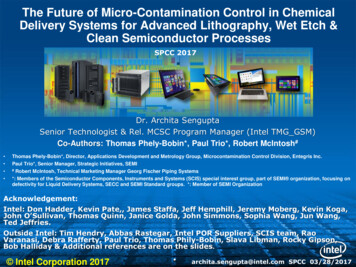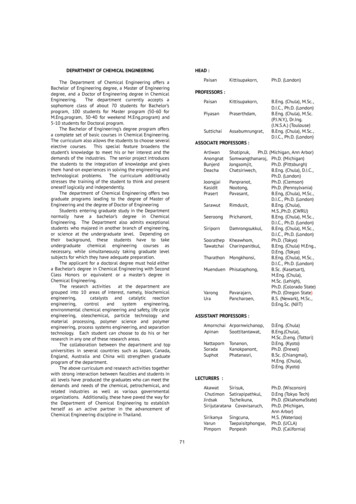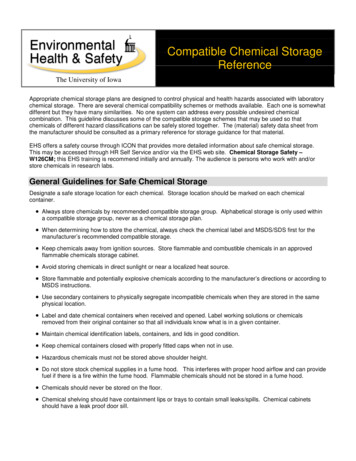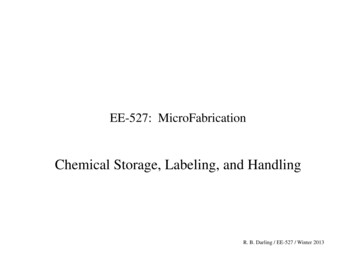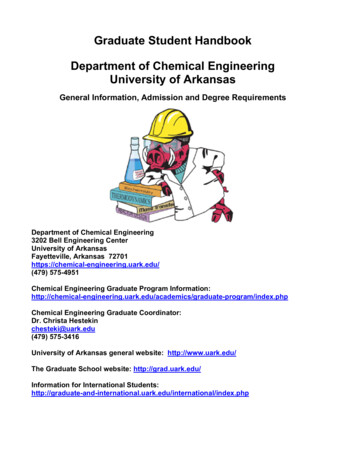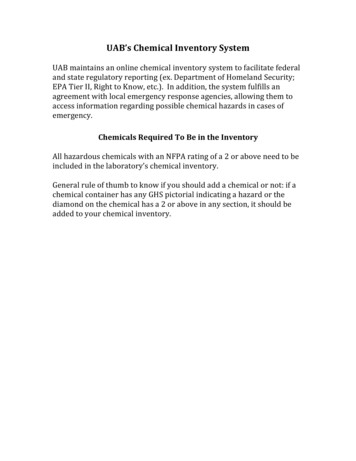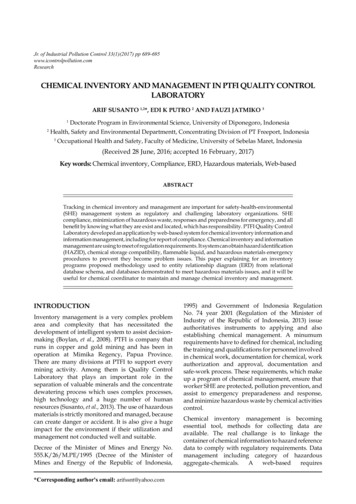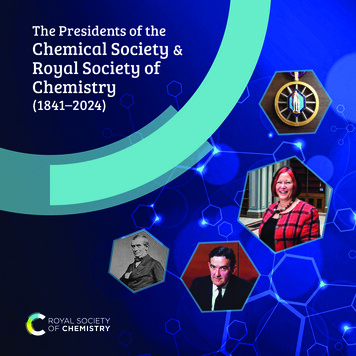
Transcription
The Presidents of theChemical Society &Royal Society ofChemistry(1841–2024)
ContentsIntroduction04Chemical Society Presidents (1841–1980)07Royal Society of Chemistry Presidents (1980–2024)34Researching Past Presidents45Presidents by Date47Cover images (left to right): Professor Thomas Graham; Sir Ewart Ray Herbert Jones;Professor Lesley Yellowlees; The President’s Badge of Office
Introduction
The other main decision made at the 30 March meeting was on the system by which the ChemicalSociety would be organised:“That the ordinary members shall elect out of their own body, by ballot, a President,four Vice-Presidents, a Treasurer, two Secretaries, and a Council of twelve, four ofwhom may be non-resident, by whom the business of the Society shall be conducted.”IntroductionOn Tuesday 23 February 1841, a meeting was convened by Robert Warington that resolved to forma society of members interested in the advancement of chemistry. On 30 March, the 77 men who’dalready leant their support met at what would be the Chemical Society’s first official meeting; atthat meeting, Thomas Graham was unanimously elected to be the Society’s first president.At the first Annual General Meeting the following year, in March 1842, the Bye Laws were formallyenshrined, and the ‘Duty of the President’ was stated:“To preside at all Meetings of the Society and Council. To take the Chair at all ordinaryMeetings of the Society, at eight o’clock precisely, and to regulate the order of theproceedings.A Member shall not be eligible as President of the Society for more than two years insuccession, but shall be re-eligible after the lapse of one year.”Little has changed in the way presidents are elected; they still have to be a member of the Societyand are elected by other members. However, nowadays the candidates undergo greater scrutiny;after the nominations have been called and received, they are evaluated by the NominationsCommittee. The committee produces a list of candidates who meet the requirements of the roledescriptor, who can demonstrate the requisite skills and experience to fulfil the role and whoconfirm their willingness to serve in this way. Successful candidates are then put forward forelection.The president is elected biennially by the membership, they then serve two years as presidentelect then two years as president. Their time of office starts from the Royal Society of Chemistry’sAnnual General Meeting held in July.In 1841, the number of Fellows was 77; in 2022, membership had grown to 50,000. At the firstmeeting, votes were cast in person; today, votes are cast online.05
IntroductionThe Presidents in brief: The youngest was Thomas Graham who was 35 when he became president Two fathers and sons have been president: Edward Frankland (16th) and Percy Faraday Frankland(37th), William Henry Perkin (23rd) and William Henry Perkin Jnr. (38th) Four men were president of the Chemical Society twice: Thomas Graham (1st and 3rd), WilliamMiller (8th and 13th), Alexander Williamson (12th and 15th) and Warren de la Rue (14th and 20th) There are eight Nobel Laureates among the past presidents: Sir William Ramsay (1904), Sir WalterNorman Haworth (1937), Sir Robert Robinson (1947), Sir Cyril Norman Hinshelwood (1956), LordAlexander Todd (1957), Lord George Porter (1967), Sir Derek Barton (1969), Sir Harry Kroto (1996) One president resigned (for health reasons), Professor Arthur Crossley in 1926 Two presidents died in office, Professor James Philip in 1941 and Professor John Purnell in 1996 Sir Ewart Ray Herbert Jones was president of both the Chemical Society (64th) and the RoyalSociety of Chemistry (1st) The first woman president was Professor Lesley Yellowlees in 2012Notes:1. In 1980, the Royal Society of Chemistry was formed with the amalgamation of the ChemicalSociety, the Society for Analytical Chemistry, the Royal Institute of Chemistry and the FaradaySociety. Each Society represented a different aspect of the chemical profession, though it wasvery common for people to be members of more than one Society, each Society had its ownpresident. This booklet only includes the presidents of the Chemical Society and then the RoyalSociety of Chemistry in order to provide a more linear history of the Society. Future versions couldinclude the presidents of the other societies, until then, their names are listed at the back of thebooklet.2. In order to demonstrate the length of time both Societies have existed, some historic milestonesare included to show how far we’ve come in the areas of science & technology and in therepresentation of diverse groups within society at large and within the Societies themselves.3. Some of the information in this introduction was taken from ‘The Chemical Society 1841–1941’ byTom Sidney Moore and James Charles Philip. Philip was president of the Chemical Society at thetime and had written four chapters of this book by the time of his death in 1941; his widow sentthe manuscript to the Chemical Society who engaged the services of Moore to complete it.4. The achievements and appointments for each president are based on editorial decisions and arenot meant to be an exhaustive list. In addition, whilst every effort has been made to thoroughlyfact-check the contents of this brochure, there may be some disputable points. Please submit anysuggested corrections or amendments to library@rsc.org06
Chemical Society Presidents(1841–1980)
Chemical Society Presidents (1841–1980)0811841–1843ProfessorThomas Graham(1805–1869) Born in Glasgow Twice president of the ChemicalSociety (1st and 3rd) A founder member of theChemical Society His studies on the diffusion ofgases resulted in ‘Graham’s Law’ Last person to hold the office of‘Master of the Mint’ after whichthe role was amalgamated intothe office of the Chancellor ofthe Exchequer21843–1845Arthur Aiken(1773–1854) Born in Warrington A founder member (and firsttreasurer) of the ChemicalSociety Studied under Joseph Priestley Lectured on chemistry at Guy’sHospital for 32 years One of the founders of theGeological Society of Londonin 180724 May 1844 The firsttelegraph message sent, bySamuel Morse from Washingtonto Baltimore31845–1847ProfessorThomas Graham(1805–1869) See entry for 1st president16 October 1846 WilliamMorton is the first person tosuccessfully demonstrateanaesthesia
1847–1849ProfessorWilliam Brande(1788–1866) Born in St James’s, London A founder member of theChemical Society Son of a former apothecary toGeorge III Lectured with Faraday for20 years Superintendent of the Coiningand Die Department at theRoyal Mint1847 Baron Lionel Nathande Rothschild became theUK’s first Jewish MP. However,he was unable to take hisseat until 1858 when therequirement to swear theChristian oath was lifted51849–1851ProfessorRichard Phillips(1778–1851) Born in the City of London A founder member of theChemical Society Dr Thomas Thomsonpronounced him one of the firstmodern analytical chemists Lectured in chemistry at theLondon Hospital, at the RoyalMilitary College Sandhurst andat St Thomas’s Hospital Curator of the Museum ofPractical Geology, Jermyn Street1849 Pfizer founded byCharles Pfizer and CharlesErhart in Brooklyn, New York61851–1853ProfessorCharles Daubeny(1795–1867) Born in Stratton, Gloucestershire A founder member of theChemical Society President of the BritishAssociation Professor of Chemistry at theUniversity of Oxford Chemist, botanist and geologist Has a type of waterlilynamed after him, NymphaeaDaubenyana Lived in the Oxford Physic(now Botanic) Garden. Aftertransforming it, he opened it upto the publicChemical Society Presidents (1841–1980)409
Chemical Society Presidents (1841–1980)71853–1855ColonelPhilip James Yorke(1799–1874) Born in England A founder member of theChemical Society Appointed Colonel during theCrimean War Chemist and mineralogist1854 An epidemic of cholerain London killed 500 people in10 days. Dr John Snow tracedthe source to a single waterpump in Soho, half a mile fromBurlington House81855–1857Professor WilliamAllen Miller(1817–1870) Born in Ipswich A founder member of theChemical Society Twice president of the ChemicalSociety (8th and 13th) Received a Gold Medal from theRoyal Astronomical Society forhis work, with William Huggins,in their attempts to identify theelements in stars using spectralanalysis The Miller crater on the southernpart of the moon was namedafter him in 19351856 William Perkininvented Mauveine, the firstsynthetic dye1091857–1859Lord Lyon Playfair(1818–1898) Born in Meerut, India A founder member of theChemical Society Studied under and became labassistant to Thomas Graham Fellow student of DavidLivingstone Studied under Justus Liebig atGiessen; undertook researchalongside Robert Bunsen Chemist to the GeologicalSurvey Oversaw the Chemical Society’smove from Cavendish Square toBurlington House MP for Leeds South from 1868and ennobled as Baron Playfairupon leaving the House ofCommons in 1892
11 1861–186312 1863–1865Sir Benjamin CollinsBrodie (1817–1880)Professor AugustWilhelm vonHofmann (1818–1892)Professor AlexanderWilliam Williamson Born in Giessen, Germany Studied under Justus Liebig atGiessen His research on aniline, withSir William Henry Perkin, helpedlay the basis of the aniline-dyeindustry First Director of the RoyalCollege of Chemistry, London After his presidency, andinspired by the success of theChemical Society, he returnedto Germany and in 1867 wasco-founder of the GermanChemical Society (GDCh) Born in Wandsworth, London Studied under Leopold Gmelinat Heidelberg and Liebig atGiessen Twice president of the ChemicalSociety (12th and 15th) In 1863, five students from theChoshu Clan in Japan cameto London to study under hisguidance Was blind in his right eye andsemi-paralysed in his left arm Developed the theory ofetherification Born in Sackville Street,Piccadilly His father was Britain’s leadingsurgeon and president of theRoyal Society Studied under Justus Liebig atGiessen Did original analysis of beeswaxfor which he was given aFellowship of the Royal Society1859 The publication ofCharles Darwin’s ‘The Origin ofthe Species’(1824–1904)Chemical Society Presidents (1841–1980)10 1859–18611864 Louis Pasteur inventsthe Pasteurisation process11
Chemical Society Presidents (1841–1980)1213 1865–186714 1867–186915 1869–1871ProfessorWilliam Allen MillerDr Warren de la RueProfessor AlexanderWilliam Williamson(1817–1870) See entry for 8th president31 January 1865 The 13thAmendment abolishing slaveryin the United States is passedby Congress(1815–1889) Born in Guernsey Twice president of the ChemicalSociety (14th and 20th) A founder member of theChemical Society Pioneer in astronomicalphotography. In July 1860, hetravelled to Rivabellosa in Spainto photograph the solar eclipseusing the Kew Photoheliographand made the first lunarstereograph images The De La Rue crater on thenorth-east of the moon is namedafter him His father, Thomas, founded theDeLaRue company(1824–1904) See entry for 12th president1869 Dmitri Mendeleevpublished his periodic table
17 1873–187518 1875–1877Sir EdwardFrankland (1825–1899)Professor WilliamOdling (1829–1921)Sir FrederickAugustus Abel Born in Churchtown, nearLancaster First president of the RoyalInstitute of Chemistry (1877–1880) Became the first Professor ofChemistry at Owen’s College,Manchester (1851) Father of Percy Frankland (37thpresident) Originated the concept ofcombining power (valence) inchemistry One of the originators oforganometallic chemistry Discovered (and named) heliumwith Sir Norman Lockyer andPierre Jules Cesar Janssen Born in Southwark, London Fullerian Professor of Chemistryat the Royal Institution President of the Royal Instituteof Chemistry (1883–1888) Contributed to the developmentof the Periodic Table Studied medicine at Guy’sHospital and later became ademonstrator there1872–1876 HMS Challengerundertakes the world’s firstlarge–scale oceanographicexpedition18 June 1873 Alice Vickerybecame the first woman in theUK to qualify as a chemist anddruggist(1827–1902) Born in London One of the original 26 studentsat the Royal College ofChemistry when it first openedin 1845 President of the Royal Instituteof Chemistry (1880–1883) An expert in the field ofexplosives; in 1889, he inventedCordite with Sir James Dewar President of the Institution ofElectrical EngineersChemical Society Presidents (1841–1980)16 1871–187310 March 1876 AlexanderGraham Bell made the firstsuccessful telephone call13
Chemical Society Presidents (1841–1980)1419 1877–187920 1879–1880Professor John Hall GladstoneDr Warren de la Rue Born in Hackney, London In 1844, was one of the 12 men, with GeorgeWilliams, at the founding meeting of the YMCA inLondon Studied under Thomas Graham at University Collegeand then under Liebig at Giessen First president of the Physical Society (now theInstitute of Physics) in 1874 An original Fellow of the Institute of Chemistry Sat on the Royal Commission on Lighthouses His daughter, Margaret MacDonald had a statueerected in her honour for her work on social reformnear her home in Lincoln’s Inn Fields where she’dlived with her husband Ramsay MacDonald Closely related to Lord Kelvin, by marriage Lecturer on Chemistry at St Thomas’s Hospital Fullerian Professor of Chemistry at the RoyalInstitution See entry for 15th president(1827–1902)1877 Thomas Edison inventedthe phonograph(1815–1889)April 1879 Publication of thefirst issue of the Journal of theAmerican Chemical Society
22 1882–188323 1883–1885Sir Henry EnfieldRoscoe (1833–1915)Sir Joseph HenryGilbert (1817–1901)Sir William HenryPerkin (1838–1907) Born in London The mineral Roscoelite is namedafter him Studied and worked withBunsen MP for Manchester South(1885–1895) Professor of Chemistry atOwen’s College, Manchester Noted for his work on vanadiumand photochemical studies Uncle of Beatrix Potter President of the Society ofChemical Industry Born in Hull Studied under Liebig at Giessen Worked at the Universityof Glasgow under ThomasThomson Established RothamstedExperimental Station in 1843,with Sir John Bennet Lawes Born in London Studied chemistry under andlater worked with ProfessorHofmann Discovered Mauveine, the firstaniline dye (at age 18) whichlater led to the foundation of thecoal-tar colour industry Father of Sir William HenryPerkin Jnr. (38th president) President of the Faraday Society,1907 (died in office)27 January 1880 ThomasEdison received the patent forthe incandescent light bulbChemical Society Presidents (1841–1980)21 1880–1882July 1885 Louis Pasteurdeveloped the first successfulvaccine against rabies15
Chemical Society Presidents (1841–1980)1624 1885–188725 1887–188926 1889–1891Dr Hugo MüllerSir William CrookesDr William JamesRussell (1830–1909) Born in Tirschenreuth, Bavaria Studied chemistry, physics,mineralogy and geology Assistant to Justus Liebig Invited to London by ProfessorHofmann and became privateassistant to Warren de la Rue Worked at Messrs. De La Rue& Co. helping to develop thelithographic colour printing forstamps Resigned as a Fellow of theChemical Society in 1915 due tohis nationality, stating that ‘it isnot desirable for a person in myposition to be a member or totake any part in the affairs, of anypublic concern or enterprise.’ Born in Regent Street, London Studied under, then assisted,Professor Hofmann at the RoyalCollege of Chemistry Pioneer of vacuum tubes Invented the Crookes Tube andthe Crookes Radiometer Discovered the elementThallium in 1861 Founder and editor of ‘ChemicalNews’ Born in Gloucester The first Demonstrator inChemistry at Owen’s College,Manchester President of the Royal Instituteof Chemistry (1894–1897), andoriginal Fellow It was at Dr Russell’s suggestionin 1882 that Council decided to‘institute a series of permanentcarbon photographs of allthe Past Presidents of the[Chemical] Society, and stronglyrecommend that the series becontinued in the future’.(1833–1915)29 January 1886 Karl Benzpatented his ‘vehicle poweredby a gas engine.’(1832–1919)1888 John J. Loud patentedthe ballpoint pen
28 1893–189529 1895–1897Professor AlexanderCrum BrownProfessor HenryEdward ArmstrongProfessor AugustusGeorge VernonHarcourt (1834–1919) Born in Edinburgh The first candidate to be awardedthe Doctorate of Science fromLondon University in 1862 Worked under Bunsen atHeidelberg then with Kolbe atMarburg Professor of chemistry andchemical pharmacy at theUniversity of Edinburgh Taught James Dewar andPrafulla Chandra Ray (the fatherof Indian chemistry) Had a lifelong fascination forknitting having invented aknitting machine as a child, inlater life he knitted mathematicalmodels of interlocking surfaces Born in Lewisham, London Studied under EdwardFrankland At the Royal College ofChemistry developed amethod of determining organicimpurities in drinking water A pioneer in organiccrystallography A member of Chemical Societycouncil from the age of 25 untilhis death Born in Chelsea, London Sir Benjamin Brodie wasHarcourt’s mentor at ChristChurch, Oxford Became a friend of CharlesDodgson (Lewis Carroll) whilst atOxford; Harcourt is believed tohave been an inspiration for theWhite Knight in ‘Alice Throughthe Looking Glass’ Taught at Christ Church, Oxford One of the first scientists to doquantitative work in the field ofchemical kinetics Invented the HarcourtChloroform Regulator and theHarcourt Pentane-air Lamp(1838–1922)6 July 1892 Dadabhai Naorojibecame the UK’s first Asian MP(1848–1937)19 September 1893 NewZealand became the firstcountry in the world to enactwomen’s suffrageChemical Society Presidents (1841–1980)27 1891–18931896 Henri Becquereldiscovered radioactivity17
Chemical Society Presidents (1841–1980)30 1897–189931 1899–190132 1901–1903Sir James DewarSir Thomas EdwardThorpe (1845–1925)Professor JamesEmerson Reynolds Born in Kincardine, Scotland Chemist and physicist Taught by, and later becameassistant to, Lyon Playfair Invented the Dewar Flask(Thermos) Developed Cordite withFrederick Abel Has a crater on the far side ofthe Moon named after him Born in Manchester Assistant to Henry Roscoe Professor of Chemistry atAnderson’s University, Glasgow Designed the GovernmentLaboratory at Clement’s Inn inhis role as Director Invented the phrase ‘MotorSpirit’ for David Lloyd George’sintroduction of a tax on petrolin 1909 Born in Dublin Professor of Chemistry at theRoyal College of Surgeons,Dublin Chair of Chemistry at TrinityCollege, Dublin Discovered Thiocarbamide in1869(1842–1923)1898 William Ramsay andMorris Travers discovered neon18(1844–1920)10 December 1901 FirstNobel Prizes awarded
34 1905–1907Sir William Augustus TildenProfessor Raphael Meldola Born in London President of the Royal Institute of Chemistry(1891–1894) Dean of the Royal College of Science Discovered that Isoprene (a precursor to syntheticrubber) could be made from Turpentine (1842–1926)17 December 1903 First controlled flight, byOrville & Wilbur Wright18 May 1904 Marie Curie admitted as the firstfemale Honorary and Foreign Fellow of theChemical Society(1849–1915)Born in Islington, LondonSon of the Chief Rabbi of LondonAssistant to Joseph Norman LockyerIn April 1875, he took charge of the Royal Societyeclipse expedition to Camorta in the NicobarIslands President of the Society of Chemical Industry(1908–1909) President of the Royal Institute of Chemistry(1912–1915) Discovered the dye ‘Meldola Blue’Chemical Society Presidents (1841–1980)33 1903–19051905 Einstein’s Special Theory of Relativitypublished19
Chemical Society Presidents (1841–1980)35 1907–190936 1909–191137 1911–1913Sir William RamsayProfessor HaroldBaily Dixon (1852–1930)Professor PercyFaraday Frankland Born in Glasgow Worked under Bunsen atHeidelberg Professor of Chemistry at UCL Isolated argon, helium, neon,krypton and xenon Original Fellow of the Institute ofChemistry Nobel Prize in Chemistry, 1904‘In recognition of his servicesin the discovery of the inertgaseous elements in air, and hisdetermination of their place inthe periodic system’ Born in Marylebone, London Studied under Augustus GeorgeVernon Harcourt at ChristChurch, Oxford Amateur footballer; in 1873,played as a forward for OxfordUniversity AFC in the secondever FA Cup Final, againstWanderers. They lost 2–0 Professor of Chemistry at OwensCollege Manchester Worked at Balliol College,Oxford and advocated for theadmission of women chemistrystudents to his lectures, this wasaccepted in 1886 Specialised in the rate ofexplosion in gases, working withthe Home Office during the FirstWorld War President of the ManchesterLiterary and PhilosophicalSociety (1923–1925)(1852–1916)1907 Karl M. Baer, fromGermany, became one ofthe first trans people to gainfull legal recognition of theirgender identity20(1858–1946) Born in London Son of Sir Edward Frankland(16th president) President of the Royal Instituteof Chemistry (1906–1909) Professor of Chemistry in theUniversity of Birmingham Served on a number ofboards during the First WorldWar including the AdmiraltyInventions Board and theAnti-Gas and Chemical WarfareCommittee1911 Ernest Rutherfordidentified the atomic nucleususing a ‘scattering’ experiment1911 Marie Curie became thefirst woman to win a NobelPrize for Chemistry
39 1915–191740 1917–1919Sir William HenryPerkin Jnr. (1860–1929)Dr Alexander ScottSir William JacksonPope (1870–1939) Born in Sudbury, Middlesex Son of Sir William Henry Perkin(23rd president) Worked under Adolf von Baeyerin Munich Professor of Chemistry atHeriot-Watt College, Edinburgh Professor of Organic Chemistryat Manchester University Born in Selkirk, Scotland Conducted an inquiry intothe conditions of objects atthe British Museum that weresaid to have deteriorated afterbeing stored in the LondonUnderground during theFirst World War Established and becameDirector of British MuseumLaboratory In 1923, visited Luxor andworked with Howard Carter toadvise on the preservation ofthe Tut-ankh-Amun relics Born in London Professor of Chemistry at theUniversity of Cambridge Worked closely with HenryArmstrong President of the Society ofChemical Industry (1920–1921) President of IUPAC (1922–1925)10 November 1913 JohnArcher was elected Mayor ofBattersea, the first black personto hold senior public office inLondon(1853–1947)1916 St. Elmo Brady becamethe first African American toattain a PhD in chemistry inthe United States, from theUniversity of Illinois atUrbana-ChampaignChemical Society Presidents (1841–1980)38 1913–19156 February 1918 TheRepresentation of the PeopleAct gave all men and somewomen the right to vote inthe UKDecember 1918 ConstanceMarkievicz became the firstwoman elected as an MP but,as a member of Sinn Fein, didnot take her seat21
Chemical Society Presidents (1841–1980)41 1919–192142 1921–192343 1923–1925Sir James JohnstonDobbie (1852–1924)Sir James WalkerProfessor WilliamPalmer Wynne Born in Glasgow Director of the Royal ScottishMuseum in Edinburgh Worked on the ResearchCommittee of the War Cabinetand the Nitrogen ProductsCommittee during the FirstWorld War President of the Royal Instituteof Chemistry (1915–1918) Born in Dundee Studied under, and later workedwith, Alexander Crum-Brown atthe University of Edinburgh andF.W. Ostwald in Leipzig Manager of H.M. Factory,Craigleith during the First WorldWar Professor of Chemistry inUniversity College, Dundee thenat the University of Edinburgh1920 Women are admitted forthe first time as Fellows of theChemical Society22(1863–1935)26 November 1922 HowardCarter and Lord Carnarvonenter the antechamber ofTut-ankh-Amun’s tomb(1861–1950) Born in Stafford Private research assistant toHenry Armstrong Undertook researches on thechemistry of naphthalene Dean of the Faculty of Science inthe University of Sheffield
45 1926–192846 1928–1931Professor ArthurWilliam CrossleyProfessor HerbertBrereton BakerSir Jocelyn FieldThorpe (1872–1940)(1869–1927) Born in Accrington Professor of Organic Chemistryat Kings College London During the First World War, actedas Secretary to the AdvisoryCommittee of the ChemicalWarfare Service and later asLieut.-Colonel R.E. in charge ofthe new experimental station inPorton Resigned as president of theChemical Society early due toill health(1862–1935) Born in Blackburn Taught by, and then becameassistant to, Harold Baily Dixonat Balliol College, Oxford Director of the ChemistryDepartment at Imperial College Discovered a compound toabsorb the phosgene deployedby the Germans in their poisongas attacks in the First WorldWar, the helmet was known asthe ‘Phenate Helmet’26 January 1926 JohnLogie Baird gave the world’sfirst public demonstration oftelevision Born in London Worked under Professor WilliamPerkin Jnr. at Owen’s College,Manchester During the First World War wasa member of the ChemicalDefence Committee President of the Royal Instituteof Chemistry (1933–1936) Discovered the Thorpe Reactionand the Thorpe-Ingold EffectChemical Society Presidents (1841–1980)44 1925–19261928 The Equalities FranchiseAct in the UK gave women thesame voting rights as men28 September 1928 AlexanderFleming discovered penicillin23
Chemical Society Presidents (1841–1980)2447 1931–193348 1933–193549 1935–1937Professor GeorgeGerald HendersonSir Gilbert ThomasMorgan (1870–1940)Professor NevilVincent Sidgwick Born in Essendon, Hertfordshire Assistant to William Tilden atthe Royal College of Science,London Mason Professor of Chemistry atthe University of Birmingham Associate Member of theChemical Warfare Committeeduring the First World War Born in Oxford Nephew of Sir Benjamin Brodie Consultant at the Dept. ofExplosive Supplies of theMinistry of Munitions during theFirst World War President of the Faraday Society(1932–1934)(1862–1942) Born in Glasgow Regius Professor of Chemistry atthe University of Glasgow An authority on the chemistryof terpene hydrocarbons,sesquiterpene chemistry andthe chemistry of India rubber,balata, and gutta-percha President of the Society ofChemical Industry (1914) President of the Royal Instituteof Chemistry (1924–1927)1935 Dorothy Hodgkinpublished her first paper assole author, ‘X-Ray SingleCrystal Photographs ofInsulin’(1873–1952)12 April 1937 Frank Whittleconducts the first groundtest of the jet engine
51 1939–194152 1941Sir FrederickGeorge DonnanSir Robert RobinsonProfessor JamesCharles Philip(1870–1956) Born in Columbo, Sri Lanka Blind in one eye as the result ofa childhood accident A pupil of Sir William Ramsay President of the Faraday Society(1924–1926), and foundermember The Donnan Equilibrium isnamed after him (aka TheGibbs-Donnan Effect)(1886–1975) Born in Rufford, Derbyshire Appointed the first Professorof Pure and Applied OrganicChemistry in the University ofSydney Nobel Prize for Chemistry(1947) ‘for his investigationson plant products of biologicalimportance, especially thealkaloids’ Known for the development oforganic synthesis Discovered the molecularstructures of morphine andstrychnine7 January 1939 MargueritePerey discovered theelement Francium, the lastnaturally occurring elementto be discovered(1873–1941) Born in Fordoun, Scotland Professor of Physical Chemistryat Imperial College Proposed a resolution on 8 May1919 at an EGM of the ChemicalSociety ‘That women shouldbe admitted to the Society onthe same terms of men’. Theresolution passed and womenwere admitted as Fellows thefollowing year President of the Society ofChemical Industry Died in office, six months afterbecoming president of theChemical SocietyChemical Society Presidents (1841–1980)50 1937–193925
Chemical Society Presidents (1841–1980)2653 1941–194454 1944–194655 1946–1948William HobsonMills (1873–1959)Sir Walter NormanHaworth (1883–1950)Sir Cyril NormanHinshelwood Born in London Friend and colleague of NevilSidgwick Worked as a demonstrator forSir James Dewar Lecturer at Jesus College,Cambridge Married fellow chemist MildredMay Gostling. In 1904, she wasone of the 19 female chemiststo sign a letter to the ChemicalSociety requesting that womenbe accepted as Fellows Born in Chorley Senior Demonstrator underSir Edward Thorpe at ImperialCollege Nobel Prize in Chemistry(1937) ‘for his investigations oncarbohydrates and vitamin C’ Married Violet Chilton Dobbie,the daughter of Sir JamesDobbie Developed the HaworthProjection, a method forrepresenting the threedimensional structure of sugaron paper Born in London Worked on the ChemicalDefence Board of the Ministry ofSupply during the Second WorldWar President of the Royal Society Nobel Prize in Chemistry (1956);awarded jointly with NikolayNikolaevich Semenov ‘for theirresearches into the mechanismof chemical reactions’ President of the Faraday Society(1961–1962)13 June 1946 Alan Turingwas awarded the Order of theBritish Empire insignia of theFourth Class (OBE) for hiswork at Bletchley Park duringthe Second World War(1897–1967)1947 Marie Maynard Dalybecame the first AfricanAmerican woman to attaina PhD in chemistry, fromColumbia University
57 1950–195258 1952–1954Sir Ian MorrisHeilbron (1886–1959)Sir Eric KeightleyRideal (1890–1974)Sir Christopher KelkIngold (1893–1970) Born in Glasgow Assistant Director of Supplies inGreece for the army during theFirst World War, gained the rankof Lieutenant Colonel Was a scientific advisor at theMinistry of Supply and theMinistry of Production duringthe Second World War Emeritus Professor of OrganicChemistry at the University ofLondon Born in Sydenham Studied for his PhD underProfessor Anschutz in Bonn During the First World War,worked with Edward Harrisonon the development of the gasrespirator. He also went to theSomme to supervise the watersupplies to the Australian troops President of the Faraday Society(1938–
Was blind in his right eye and semi-paralysed in his left arm Developed the theory of etherification . Institute of Chemistry (1877-1880) Became the first Professor of Chemistry at Owen's College, Manchester (1851) . Pierre Jules Cesar Janssen Professor William Odling (1829-1921) Born in Southwark, London.




